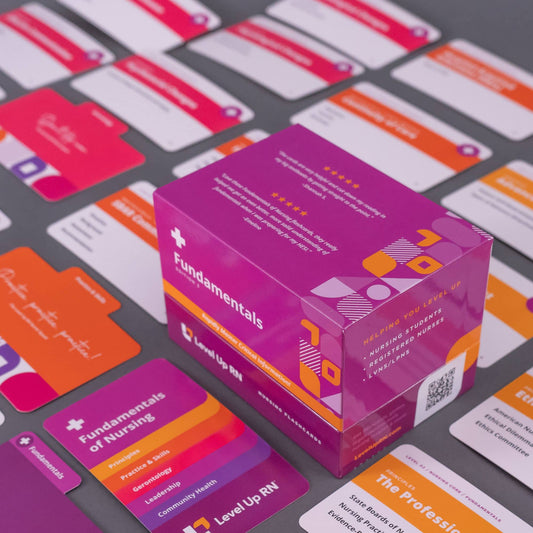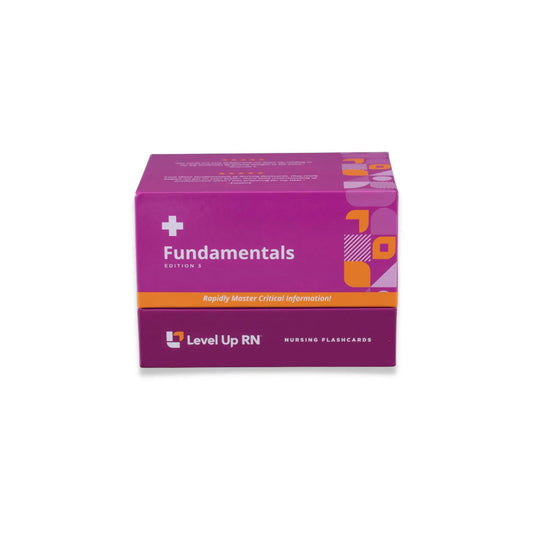Fundamentals of Nursing - Flashcards
This article focuses on mobility devices — canes, walkers, and crutches. Many of your patients will require mobility devices, so this is important information to know.
You can follow along with our Fundamentals of Nursing flashcards, which are intended to help RN and PN nursing students study for nursing school exams, including the ATI, HESI, and NCLEX.
 When you see this Cool Chicken, that indicates one of Cathy's silly mnemonics to help you remember. The Cool Chicken hints in these articles are just a taste of what's available across our Level Up RN Flashcards for nursing students!
When you see this Cool Chicken, that indicates one of Cathy's silly mnemonics to help you remember. The Cool Chicken hints in these articles are just a taste of what's available across our Level Up RN Flashcards for nursing students!
Canes
A patient using a cane should hold it on their strong side, also called the "good" side or the "unaffected" side.
To find the best height for a patient's cane, ensure that the handle of the cane is at the level of the patient's wrist or greater trochanter. The greater trochanter is the big bump on the femur right below the hip. It usually aligns with where the wrist falls when the patient's arm is by their side. Also, the patient's arm should be slightly bent at the elbow. If the patient has to straighten their arm to use the cane, the cane is not the correct size for that patient.
When using a four-pronged cane, make sure that the flatter side is toward the patient's body versus the rounded side, which should face out. This is to keep the patient from tripping and falling over the prongs. Always make sure that two points of support are on the ground at all times when using a four-pronged cane.
When walking with a cane: first place the cane 6 – 10 inches forward; next, move the weak (affected) leg forward to the cane; then advance the stronger (unaffected) leg past the cane.
Walkers
As with canes, the height of a patient's walker should be at wrist level when the patient's arms are by their sides. And, as with a cane, the patient's arm should be slightly bent at the elbow (approximately 30 degrees) when they use a walker — no straight arms, which could lead to discomfort and possible injury.
If a patient uses a walker and they are sitting in a chair, when they wish to get up, they must learn to use the arms of the chair for assistance. They should never use the walker. This is because the walker is not fixed to the ground, so if the patient tries to pull themselves up using the walker, they may pull the walker over, which could result in their falling down and getting injured.
When using a walker: first, push the walker forward; then, move the weak (affected) leg forward inside the walker; then, step forward with the stronger leg inside the walker.
Crutches
Crutches are assistive devices used to help a patient ambulate. When the lower extremities are affected (for example, a broken ankle), crutches allow the patient to move independently, transferring their body weight from their legs to their torso and arms.
One of the most important things about crutches is ensuring they are adjusted to the right height. When properly set, the underarm pad should sit 2 inches below the axilla (armpit) when the shoulder is at rest. Many important nerves and blood vessels run through this area, and crutches that are too high — that rest in the axilla — will cut off circulation, which could lead to discomfort and injury. Crutches with properly adjusted hand grips will allow elbow flexion of 30 degrees.
When using crutches, the patient should put their weight on their hands, that is, on the hand grips, and not put their weight on the pad under the axilla.
Crutch gaits
There are a number of different crutch gaits, or methods of moving when using crutches. A patient should choose the gait that allows them to move independently but that takes into consideration their current injury or deficit as well as their degree of coordination:
- Two-point gait: move the opposite crutch and leg together (e.g., left leg/right crutch), followed by the other crutch and leg (right leg/left crutch)
- Three-point gait: move both crutches forward with the injured leg, allowing the unaffected leg to bear the patient's weight, then advance the uninjured leg
- Four-point gait: this gait provides the most support; move one crutch, then the opposite leg, then move the second crutch, followed last by the other leg (e.g., left crutch, right leg, right crutch, left leg); think of this as "walking on all fours"
- Swing-through gait: first, both crutches are advanced simultaneously, then both legs move forward (swing-through) at the same time; this is the most common image that comes to mind when thinking of somebody using crutches
- One-crutch gait: for this gait, the crutch is used on the strong (uninjured) side; move the crutch forward at the same time as the injured leg, then move the uninjured leg forward while the crutch supports the patient's weight
Using stairs with crutches
When climbing (ascending) stairs, the patient should position their unaffected (strong) leg next to the stair railing, then hold the handrail on that side. Position the crutch under the axilla (armpit) of the other (affected, or weak) side, then step up with the unaffected leg. Next, bring the affected leg and crutch up to the step.
When descending stairs (coming down), position the affected leg next to the stair railing and hold the handrail on that side. Position the crutch under the axilla on the other (unaffected) side. Lower the crutch one step, then move the affected leg down. Last, move the unaffected leg down to the step.
 Up with the good, down with the bad!
Up with the good, down with the bad!



1 comment
The way you present the information to retain for testing is exactly what is needed in any nursing program. Direct and clear. No one does it better than you.